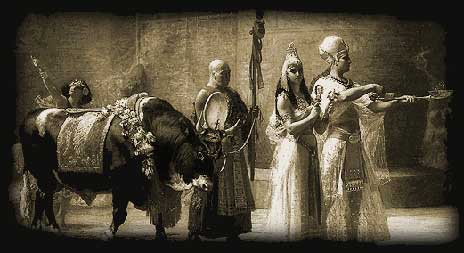 |
|
 |
|
What were the Apis Bulls?
"The Apis Bull",
wrote Herodotus, "is the calf of a cow which is never
able after to have another. The Egyptians believe that a flash
of lightning strikes the cow from heaven, and thus causes her
to conceive the Apis. It has distinctive marks. It is black, with
a white diamond on its forehead, the image of an eagle on its
back, two white hairs on its tail and a scarab-beetle mark under
its tongue".
The Apis bulls (along with the Mnevis bull and the Buchis bull)
were considered to be the earthly incarnation of a god - but unlike
other animals who could only intercede with deities on behalf
of humans, the Apis Bull was believed to be the very god himself
living amongst the human population. Apis was the manifestation
of Osiris, Mnevis of Re-Atum and Buchis of Re, all three were
chosen for their special markings and were indeed treated as gods
on earth - when the bulls died they were then mourned, mummified
and then buried with the same glory that occurred with the death
of a pharaoh.
Although the Apis Bull associated with Osiris, the Apis Bull was
worshipped in Egypt from a much earlier date than that of Osiris
- Osiris became universally accepted as the god of the dead at
the end of the Old kingdom, whereas there is mention of the Apis
Bull as early as the First Dynasty and could even go back into
Predynastic times. However, the Apis Bull was worshipped because
he was Osiris and is found with the name Apis-Osiris - according
to Plutarch "Apis was a fair and beautiful image of the soul
of Osiris'.
All oxen which were 'clean' (entirely free from black spots, or
even a single black hair) were chosen as a sacrifice to the Apis
Bull.
Where did it Live?
It was in Memphis that the Apis bulls were kept and where the
worship of them was particuarly keen. Psammaticus erected a grand
court with columns '12 cubits' in height in which the Apis was
kept when he was paraded in public. Attached to this court were
two stables ('delubra' or 'Thalami') - and in front of these stables
was a vestibule where the Apis was introduced to strangers, but
also it was a place in which the mother of the Apis was fed.
The Festival of the Apis Bull
The festival in honour of Apis lasted seven days, during which time a large amount of people would gather at Memphis. The priests would led the sacred bull in a solemn procession through the crowds of people who welcomed the bull as he past - the children who smelt his breath were thought to be gifted with the power of predicting future events.
Apis as an Orcale
As the Egyptians considered the Apis Bull to be the living image of Osiris they consulted him as an oracle and took his actions to mean good or bad omens. If the bull took what food was offered him, after the asking of a question, then the omen was good - if the food was refused then it was considered a sinister omen.
Death of the Apis
When the Apis died, specially
chosen priests went in search for another bull with the signs
noted above. As soon as a bull was found he was taken to 'the
city of the Nile' for 40 days before he was moved to Memphis -
during this time only women were allowed to attend him. When the
40 days were completed the bull was transferred to Memphis using
a boat with a specially constructed golden cabin.
Pliny and Ammianus state that the priests themselves drowned the
Apis Bull had reached 25 years of age (the time prescribed to
the life of Apis Bulls in the sacred books), beyond which the
bull was forbidden to live. The body was then embalmed and a grand
funeral procession took place at Memphis - the sarcophagus was
placed on a sledge, followed by the priests dressed in leopard
skins and uttering cries to their god.
When the Apis died of natural causes his funeral rites were much
more ostentatious - so much so that the cost of the funeral placed
a heavy burden on the Pharaoh in power at the time.
Whatever the cause of death, upon the death of an Apis Bull the
people went into mourning, as if Osiris himself died, until his
successor the Apis was found - then rejoicing commenced with as
much joy as there was grief when the original Apis died.
